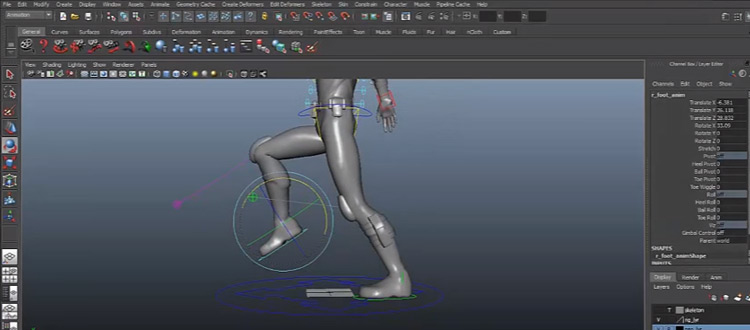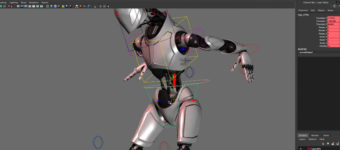
Top 10 Best 3D Animation Books
Entertainment art is a huge industry that goes far beyond 2D work. Modern animation for movies and games often relies on 3D software for modeling, rendering, rigging, and animating characters.
These jobs are in high demand but there’s also a large supply of applicants. If you’re good you can get in but you’ll need to put in the work.
If you love 3D animation and want to get started I’ve collected the 10 best books for beginners and intermediate-level animators. These books teach the fundamentals of animation and 3D software from scratch. Regardless of your skill level with 3D I guarantee you can find something valuable in this collection.
And if you prefer video tutorials check out the Pluralsight 3D animation courses. These step-by-step videos go into detail on 3D animation for beginners and you can even test the waters with a free trial.
The Animator’s Survival Kit


No animator can expect to get far without reading The Animator’s Survival Kit. It may seem rude to make this assumption but even professional animators frequently rely on this book.
It is by far the best resource on lifelike animation techniques. It does assume some level of knowledge and it mostly targets 2D animation. But the skills and resources in the book can easily apply to 3D animation. In fact the book’s author Richard Williams helped Disney with their hit 3D film Toy Story.
You’ll get hundreds of unique diagrams and drawings made to illustrate each point in the book. Through quick tips and exercises you quickly learn the true values of animation and how these apply universally to 2D and 3D work.
It’s a very large book at 342 pages and each chapter beams with rare informative tips for aspiring animators. I simply cannot recommend this book enough.
If you’re serious about animation then you absolutely need a copy of this book at your workstation.
3D Animation Essentials


If you don’t know anything about 3D animation then you should check out 3D Animation Essentials. It’s a brilliant introductory book that holds your hand throughout the entire teaching process.
It feels like a whole curriculum mashed into a book made for beginners who need a starting guide. You’ll learn about the entire 3D production workflow including pre-production concepts, modeling, animating, rendering, and post-production touch-ups with VFX work.
Over the course of 350 pages skilled animator Andy Beane shares the fundamentals of 3D animation from the inside-out. It’s a very approachable book even for novices who have no idea how animation is created.
Some chapters even include Q&As with animation professors and industry veterans who share their tips on particular subjects.
You won’t learn everything from reading this book. However you will get all the foundational knowledge you need to feel confident approaching 3D animation as a career.
3D Art Essentials


With so many different programs available it can be tough knowing where to start. 3D Art Essentials takes software out of the equation by teaching the core 3D skills without any particular program.
You’ll learn about modeling characters, creating realistic poses, building textures and animating your own shots. These tips focus more on the general how-to angle rather than specific details. But the author does recommend the best programs for each stage including Maya, Blender, and ZBrush.
Most new animators just don’t understand the pipeline or the terminology. This book will set you straight teaching all the most important pieces of information without requiring you to learn a certain 3D rendering program.
This is another lengthy book at 288 pages long and well worthing picking up if you’re new to the 3D animation industry.
The Art of 3D Computer Animation and Effects


Once you’re ready to get into the nitty-gritty industry techniques then you’ll want a book that delivers on more advanced topics. The Art of 3D Computer Animation and Effects is literally a guide on the best tips, techniques, and resources for modern 3D animation.
Currently in its 4th edition, this book includes tips for animators at every level of the pipeline. Animators from big name studios offer their tips so you’ll be learning from members of Disney, Pixar, Blue Sky, Ubisoft, Electronic Arts, and dozens of other entertainment studios.
I cannot overstate how amazing this book really is. You’ll learn practical guides for creating realistic animations, visual effects, timing, and modeling characters into poses that blend perfectly with a scene.
You do not need any 2D artistic knowledge to dive into this book. However it helps if you already have some knowledge of animation.
The book comes with over 700 unique diagrams and illustrations explaining each part of the animation process. I would recommend this mostly to intermediate-level animators but it can be valuable to anyone with enough tenacity to work through the content.
Digital Modeling


No 3D production is possible without high quality models. The best modelers know their place in the pipeline and it’s crucial that every animator understand this as well.
Digital Modeling by William Vaughan is the ultimate resource guide for animators and aspiring modelers. You’ll learn all the essential skills for 3D modeling which can be applied to any program like 3DS Max, ZBrush, or Maya.
If you’re into ZBrush I actually covered the best ZBrush books which may be helpful in conjunction with Digital Modeling.
This book is 430 pages long teaching the basics of different programs, why to model, details like polygon count, various surface types, plus a free training video on a few techniques in the most popular modeling programs. Later chapters get into the entertainment industry sharing tips on how to land a great job.
Excellent book for anyone interested in the modeling process and also very useful for aspiring 3D animators.
The Complete Guide to Blender Graphics


Blender is one of the premiere programs for 3D rendering.
It’s managed by a non-profit company so it’s a great choice for beginners because you can download it for free.
But learning and becoming proficient with Blender is another topic altogether. The Complete Guide to Blender Graphics targets newbies who have no idea where to get started. The book is just shy of 600 pages long so it’s truly massive.
The author starts with Blender’s GUI and the interface features. Then he delves into the typical 3D workflow using practice exercises to teach along the way.
You’ll learn about different content layers in the rendering process and how to actually animate your content. The later chapters get into Python scripting and custom add-ons to improve your Blender workflow.
This is not the only program you should learn but it’s often a great starting point for beginner’s with little money to spend on their education.
3D Animation for the Raw Beginner Using Maya


Another champion program in the animation space is Maya. This is huge and it’s used by major companies like Disney, Square-Enix, and even the South Park animation team.
3D Animation for the Raw Beginner Using Maya teaches how to get started with this incredible program. Many users would agree that Maya has a steep learning curve and it takes time to nail down the basics, let alone get into more advanced stuff.
Also Maya can be utilized for many different purposes so it’s tough to pinpoint one single correct workflow.
This book targets people specifically interested in 3D animation and it reads like a college textbook—mostly because the author is actually a professor at the University of Colorado Boulder.
I cannot recommend this book highly enough. Anyone serious about 3D animation will stumble onto Maya at some point. Beginner’s will struggle, but with tenacity they can learn all the big Maya fundamentals from this book.
However if you’re starting cold with animation I recommend grabbing a simpler guide like 3D Animation Essentials in addition to this Maya book.
The Illusion of Life: Disney Animation


If there’s any holy grail of animation it’s The Illusion of Life: Disney Animation. This book is wildly popular and for good reason. It teaches all the core principles that made Disney’s movies so great, and what makes the company a titan of industry in the modern era.
You’ll learn how Disney artists create films starting from the very first idea and moving all the way through to the final production. You’ll find plenty of tips and timeless suggestions in these written words. And while this isn’t a how-to book it can help you learn some basic animation concepts.
Many things have changed since the early days of Disney. The company has since completely abandoned 2D and this leaves a lot of room for 3D animators to break into the industry.
The old masters were brilliant animators and their knowledge applies just as much to modern 3D work as it did to 2D work decades ago.
The Illusion of Life is definitely a book worth reading for inspiration and insight into the creative animation process. But keep in mind this isn’t a 3D tutorial and it will not inherently make you a great 3D animator.
But it will help you become a more educated and insightful animator.
Cracking Animation: The Aardman Book of 3-D Animation


The creators of Wallace and Gromit team up for this incredible 3D stop-motion animation book. Cracking Animation: The Aardman Book of 3-D Animation teaches fundamental techniques for creating your own stop motion animated film.
This book does not touch upon traditional 3D rendering but it does cover a lot of the technology used in the movie Chicken Run along with the Wallace and Gromit cartoons. This is valuable to animators who want a wider breadth of options for their animation work.
In the updated version of this book you’ll find expanded interviews with other animators and directors that worked on related 3D animated films. They share tips and tricks for aspiring animators who want to get into the industry.
This book is partly a guide and partly a behind-the-scenes look into the industry. It doesn’t offer any strict workflows but it does teach the fundamentals of 3D animation in a practical manner.
Animation Methods – Rigging Made Easy


Lastly we come to one of the best books you can get on rigging for animation. The general process of rigging involves creating a skeleton for your characters so they can be moved easily with animation software.
Animation Methods – Rigging Made Easy teaches the basics of character rigging with Maya. You’ll learn everything there is to know about rigging without the fancy technical mumbo jumbo.
This is often a difficult subject to broach, especially for beginners. However Rigging Made Easy makes it, well, super easy!
You get clear exercises and instructions to help you understand the proper way to rig characters from scratch.
Animators will need to learn about rigging if they ever want to work in 3D. I’d highly recommend this book as a starting point because it offers a low barrier to entry with a very simplistic writing style.
Every book in this post is incredibly valuable to aspiring animators but for different reasons. 3D animation has taken over the world and the trend doesn’t seem to be slowing down.
For complete beginners I’d recommend grabbing 3D Animation Essentials and maybe a software book like The Complete Guide to Blender Graphics. With these two titles you can learn the core fundamental skills and then slowly move into other books that pique your interest.












